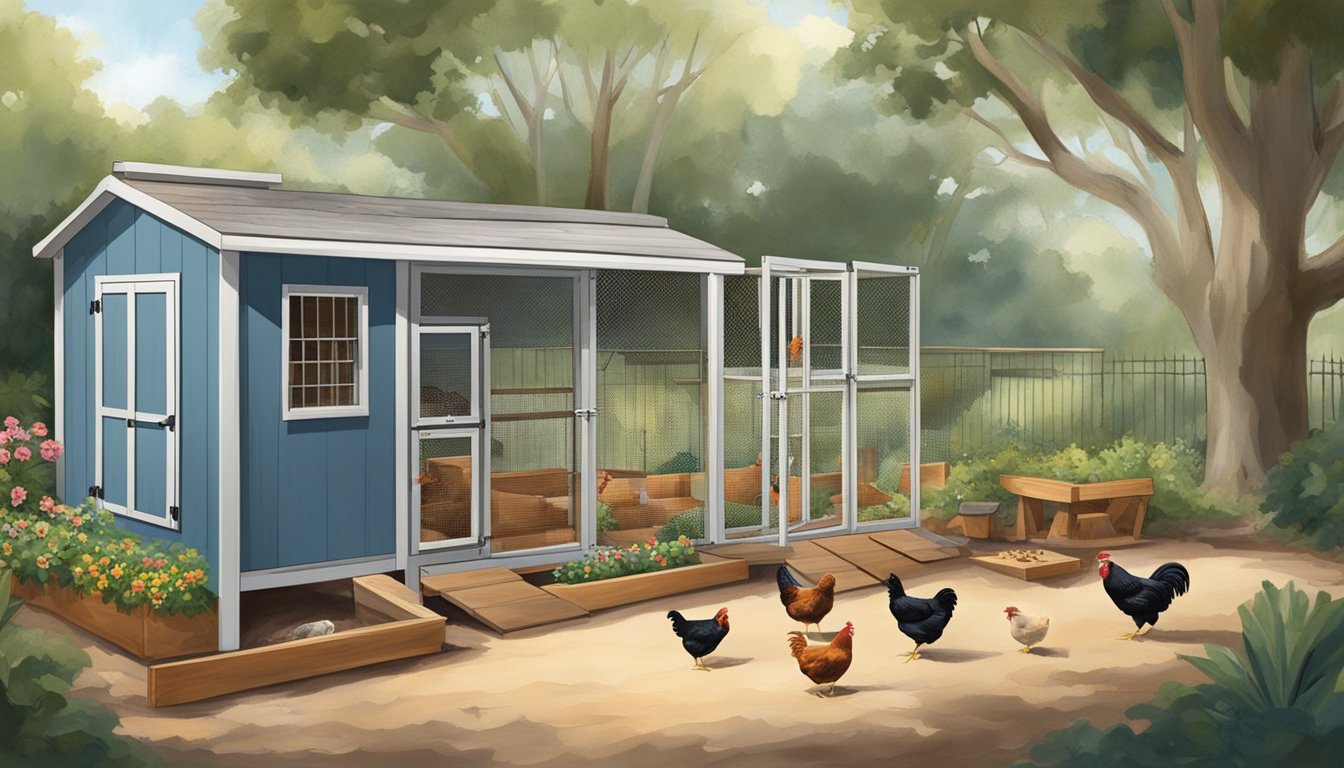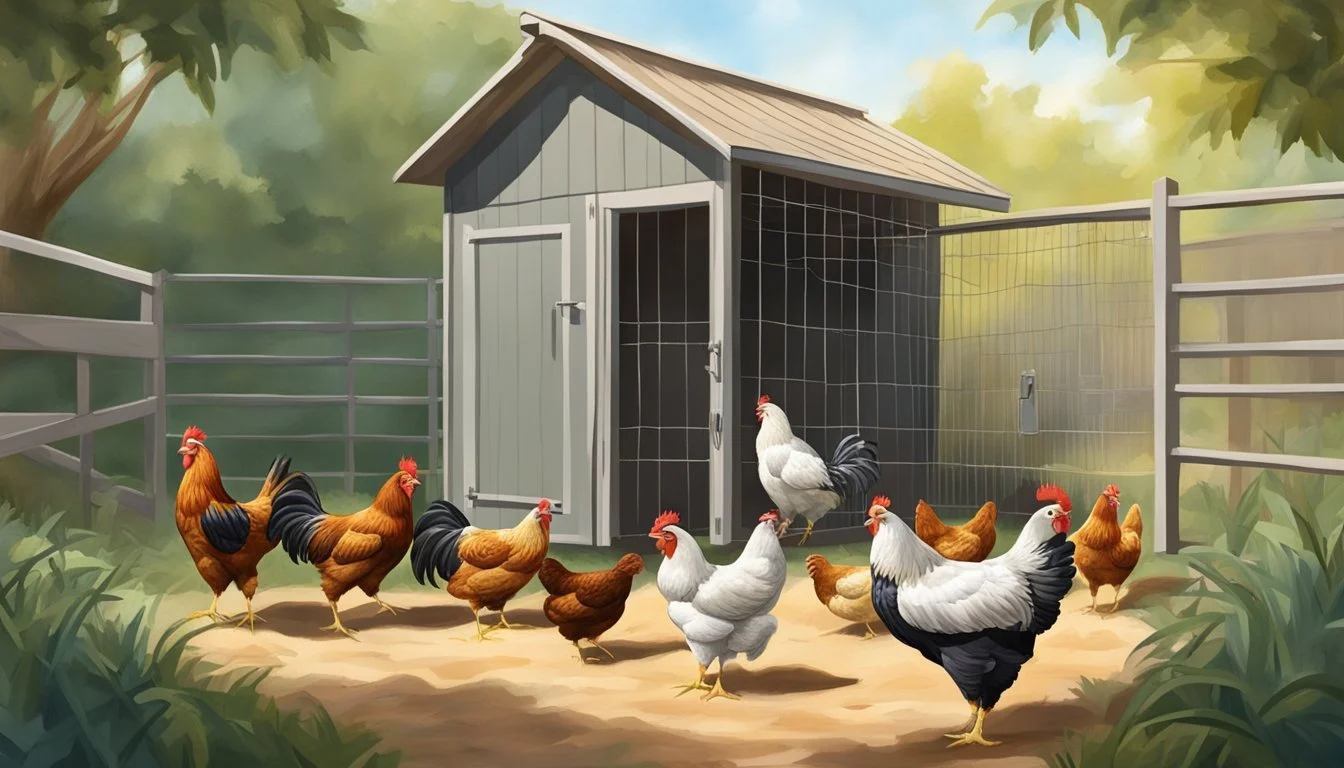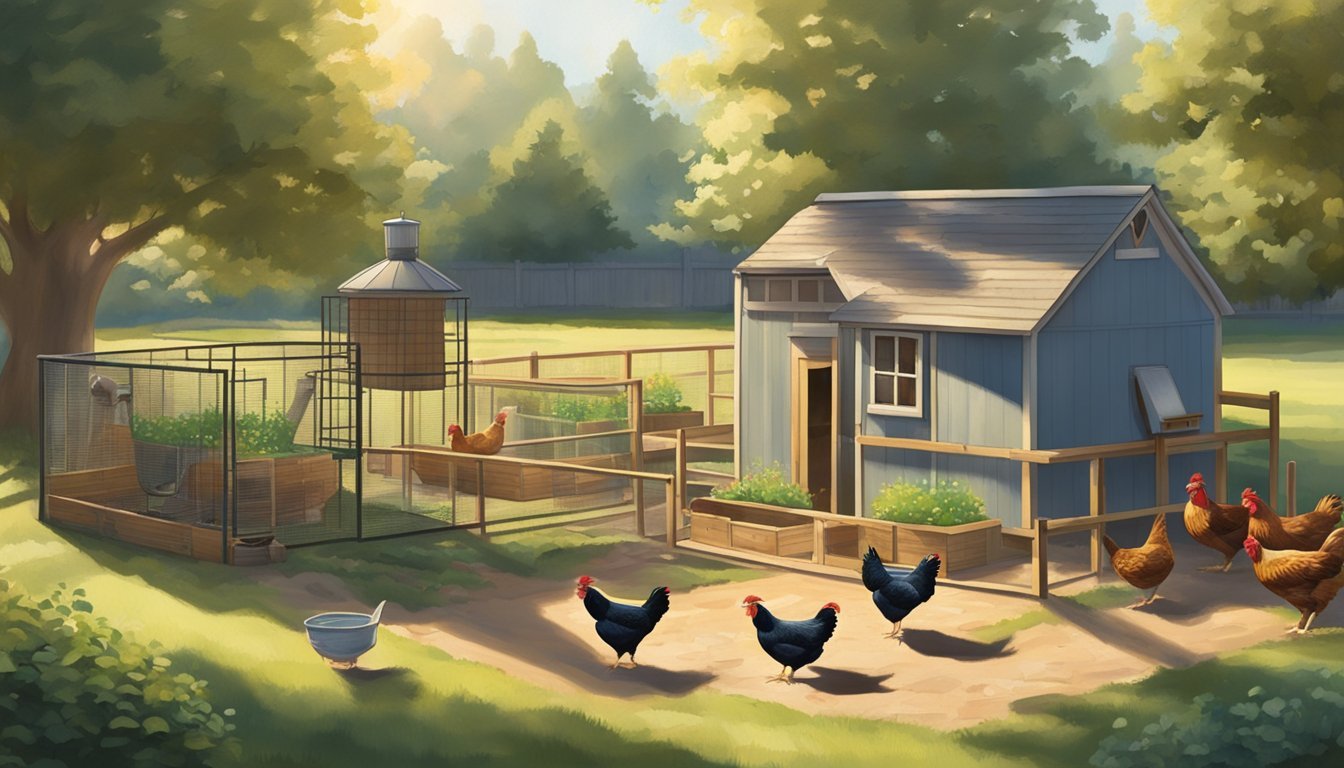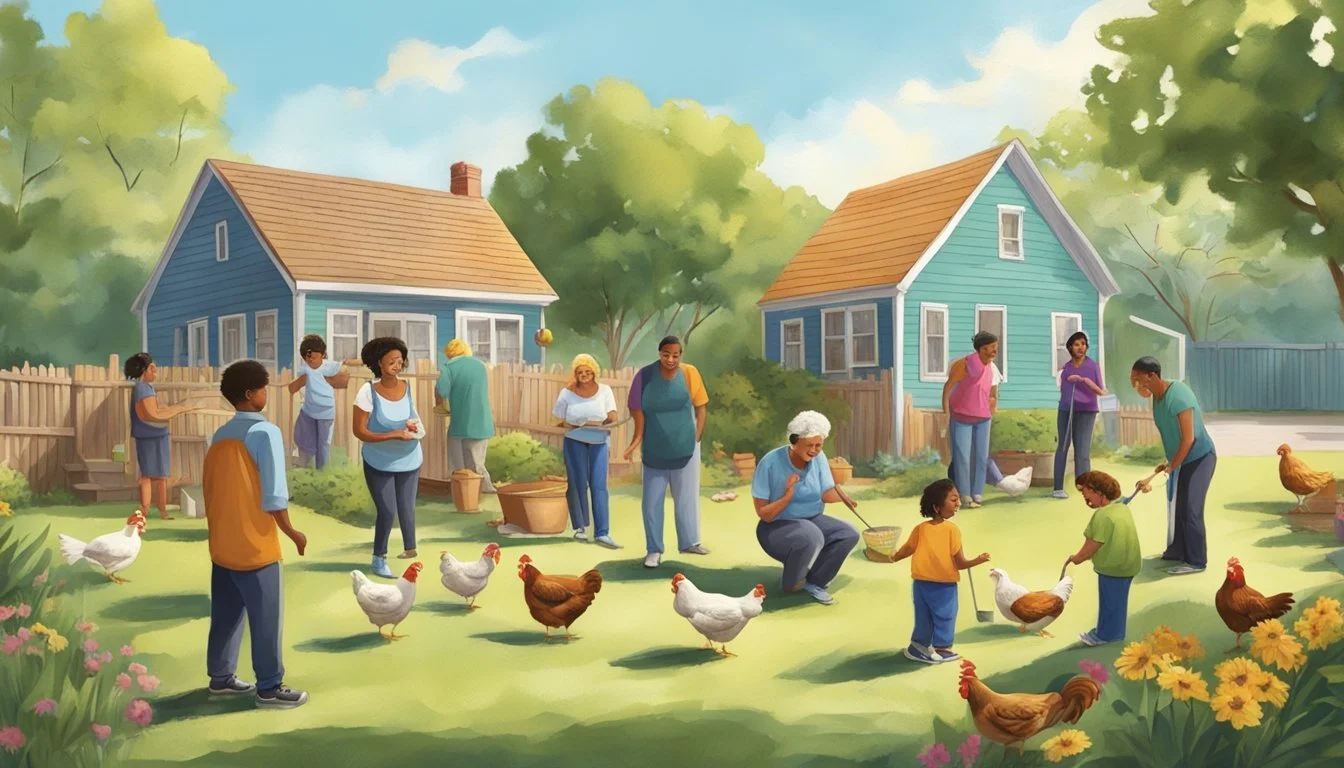Raising Backyard Chickens in Largo, FL
A Step-by-Step Guide for Beginners
Raising backyard chickens in Largo, FL, is a flourishing practice embraced by residents seeking a slice of agricultural life within urban settings. This hobby provides not only the joy of caring for poultry but also the reward of fresh eggs. A community of chicken keepers in Largo actively shares experiences, emphasizing the burgeoning interest in this sustainable practice. The city’s engagement with chicken keepers, often featuring in local media, demonstrates the appreciable local interest and support for backyard flocks.
Understanding the legal framework is crucial for prospective and current chicken keepers in Largo. City ordinances and homeowner association rules guide the keeping of backyard chickens, ensuring harmony within the community and welfare for the poultry. While regulations may vary, with some allowances for the number of chickens and the necessity of permits, Largo residents typically navigate these with ease, thanks to the accessible information from local government and online community forums focused on responsible poultry husbandry.
There is a noticeable trend of municipalities adapting their policies to accommodate the growing interest in backyard poultry. In the wider Pinellas County, cities like St. Petersburg permit the raising of chickens, reflecting a regional openness to urban agriculture. This local movement is part of a larger shift towards self-sufficiency and environmental stewardship, with Largo's chicken enthusiasts playing a pivotal role in this community-focused lifestyle shift.
Understanding Local Chicken Regulations
When raising backyard chickens in Largo, Florida, residents must be well informed about the specific local ordinances and homeowner association rules that govern poultry keeping within various communities.
Grasping Largo's Local Ordinances
In Largo and the wider Pinellas County area, individuals considering keeping chickens must refer to the local ordinances to understand the exact requirements. Each municipality within Pinellas County, such as Belleair, Dunedin, Gulfport, and St. Petersburg, may have distinct regulations, thus making it paramount to consult the local ordinance for your area. The city of Largo, for example, provides detailed rules about the number of hens allowed, coop specifications, and setback requirements from neighboring properties.
Setback Requirements: Typically involves distance from coop to property lines.
Coop Specifications: Can include size, construction, and maintenance standards.
Number of Hens Allowed: Often based on lot size or zoning requirements.
Navigating HOA and Community Rules
In addition to local regulations, poultry keepers must also consider the rules set forth by their Homeowner Associations (HOA). These rules can sometimes be more restrictive than local ordinances, and they potentially override local laws. It's essential to review your HOA's covenants, conditions, and restrictions (CC&Rs) to ensure compliance.
HOA Restrictions: May include coop aesthetics, noise control measures, or outright bans.
Compliance: It is critical for residents to adhere to these rules to avoid penalties.
For those living in Largo and surrounding communities within Florida, understanding and following the pertinent local and HOA regulations is essential for legally and responsibly raising backyard chickens.
Choosing the Right Chicken Breeds
In Largo, Florida, successful backyard chicken raising hinges on selecting breeds that thrive in the local climate and meet the owner's goals for egg and meat production.
Selecting Breeds for Largo's Climate
Largo, Florida, is characterized by its humid subtropical climate, which means heat tolerance is a primary consideration for chicken breeds. Breeds like the Leghorn and Rhode Island Red are well-suited for this environment due to their hardiness. Leghorns are particularly heat tolerant and adept at egg-laying, while Rhode Island Reds provide a balance between egg production and meat yield.
Leghorns: Excellent egg layers, white eggs
Rhode Island Reds: Good for eggs and meat, brown eggs
Egg Production and Meat Yield Considerations
Egg production is often a priority for backyard poultry enthusiasts. For a consistent supply of eggs, breeds such as the Australorp and Leghorns are strong choices, laying over 250 eggs annually. The Australorp is known for its brown eggs, whereas Leghorns lay white eggs. For those interested in both egg and meat production, Plymouth Rock and Orpington chickens, like the Buff Orpington, are dual-purpose breeds that offer moderate egg-laying capabilities alongside favorable meat yield.
Australorp: Over 250 brown eggs per year
Buff Orpington: Ideal for eggs and meat
Pros and Cons of Popular Breeds
Australorp: These chickens are docile and great for families, but their large size means they need more space than some other breeds.
Rhode Island Red:
Pros: Robust and adaptable, laying 250-300 brown eggs a year
Cons: Can be more aggressive than some other breeds
Orpington (e.g., Buff Orpington):
Pros: Gentle and good for cold weather, plus they are dual-purpose
Cons: Feathers possibly more susceptible to the Florida humidity
Consider breeds such as the Ameraucana, known for laying eggs with colorful shells, to add novelty to your flock. However, make sure to balance the appeal of unique egg colors with pragmatic factors like climate suitability and production efficiency.
Setting Up Your Chicken Coop
When creating a space for backyard chickens in Largo, FL, a well-designed chicken coop is crucial for the birds' safety, comfort, and productivity. It should provide enough room to move, rest, and exhibit natural behaviors, be secure from predators, and have adequate ventilation.
Designing an Efficient Coop Layout
An efficient coop layout is key to managing a healthy flock. The coop should have a designated area for feeding, roosting, and laying eggs. Roosting bars should be placed higher than the nesting boxes to discourage chickens from sleeping in the nests, which can lead to soiling of the eggs. The layout must allow for easy human access for cleaning and egg collection without disrupting the birds’ routine.
Providing Adequate Shelter and Floor Space
Each chicken requires at least 2-3 square feet of floor space inside the coop and 8-10 square feet in an enclosed run if they are not free range. The coop must be sturdy to shelter the flock from storms and extreme temperatures. Flooring materials should be easy to clean – many keepers use straw or wood shavings. The space must also secure against digging predators with a solid, buried perimeter of chicken wire or hardware cloth.
Ensuring Proper Ventilation and Protection
Good ventilation helps maintain air quality and prevents moisture buildup, which can lead to respiratory issues in chickens. At the same time, the coop should be free from drafts, especially in the roosting areas. Install vents or windows near the roof to allow hot air to escape. Protection involves not only a sound structure but also secure latches on doors and proper mesh or chicken wire to keep predators such as raccoons, foxes, and hawks at bay.
Maintaining a Healthy Flock
In raising a healthy backyard chicken flock in Largo, Florida, one must prioritize balanced nutrition and rigorous sanitation practices to ensure the well-being of the chickens and the safety of the eggs and meat they produce.
Nutrition and Feeding Essentials
A chicken's diet is pivotal for its health and the quality of its produce. Layer feed is a fundamental component of a chicken's diet as it is formulated to provide the necessary protein and calcium levels required for laying hens. Rhode Island Reds and White Leghorns, popular breeds in backyard flocks, thrive on a high-quality layer feed. Supplementing the feed with kitchen scraps and greens provides variety and additional nutrients. However, owners should avoid giving chickens harmful scraps like onions or chocolate.
Recommended Protein Levels: Layer feed should contain 16-18% protein for optimal health.
Calcium Supplementation: Offer oyster shells separately to provide extra calcium for stronger eggshells.
Managing Sanitation and Biosecurity
Maintaining cleanliness reduces disease risk and enhances biosecurity in a backyard flock. Regular cleaning schedules should include replacing bedding and disinfecting surfaces using appropriate disinfectants. The use of a chicken tractor can facilitate natural ground sanitation by moving chickens to fresh areas, reducing the buildup of waste and the spread of parasites.
Sanitation Checklist:
Daily: Replace soiled bedding and provide clean water.
Weekly: Clean feeders and disinfect water containers.
Monthly: Conduct thorough coop cleanings and inspect for signs of pests.
Preventative measures are essential for food safety. Limit flock exposure to wild birds and implement a routine for cleaning footwear and hands before and after interacting with the chickens.
Daily Routines and Chicken Care
Raising chickens in a backyard setting necessitates a commitment to daily care, ensuring the chickens' needs are met for optimal health and egg production. This includes structured routines for egg collection and regular observation of health and behavior.
Egg Collection and Handling
Daily egg collection is a pivotal task in chicken care. Owners should collect eggs from the nesting boxes at least once a day. It is critical to gather the eggs with care to avoid breakage and to check for any signs of irregularities or defects. After collection, eggs should be wiped clean with a dry cloth and stored in a cool place if not being used immediately. In Largo, FL, where temperatures can threaten freshness, storing eggs at a consistent, cool temperature is important.
Egg management may differ if one is dealing with fertilized eggs intended for hatching or if eggs are collected to sell. For those intending to sell, adherence to local regulations regarding the sale of fresh eggs is imperative.
Monitoring Chicken Health and Behavior
Chickens exhibit behaviors and health signs that require regular monitoring. Factors such as changes in activity levels, eating habits, and the condition of their feathers can indicate stress or illness. Chickens must have access to ample resources, including clean water, nutritionally balanced feed, and space to roam. A comfortable perch area is also necessary for their well-being.
Temperature regulation in Largo, FL, is particularly important. Owners must ensure that coops are ventilated adequately during the hot months and protective measures are in place during cooler times. Monitoring daily temperature and modifying the coop environment as necessary helps prevent stress among the flock, crucial for maintaining health and consistent egg production.
Starting With Chicks
When one begins the journey of raising backyard chickens in Largo, FL, starting with chicks requires attention to their early life stages. These initial steps are crucial for the health and wellness of the poultry.
Understanding the Brooding Period
The brooding period is the first critical stage after hatching, where chicks must be kept in a controlled environment, known as a brooder. The brooder acts as a surrogate mother, providing warmth, shelter, and protection. For the initial setup of a brooder, one must maintain:
Temperature: The brooder should be set to 90°F during the first week and gradually decrease by 5°F weekly until reaching 55°F.
Bedding: Pine shavings are typically used as bedding in the brooder for their absorbent qualities and ease of cleanup.
Space: Each chick should have 2 to 3 square feet of space to prevent overcrowding and ensure comfort.
These conditions mimic the warmth and safety that a mother hen would provide.
Acclimating Young Chickens to the Outdoors
Once chicks have grown enough to regulate their body temperature, they can be acclimated to the outdoors. This transition is typically begun after the first six weeks. Acclimation should be gradual, allowing chicks to adapt to changing temperatures and their new surroundings. Here are some specifics for a smooth transition:
Duration: Start with short, supervised periods outside, slowly increasing time as chicks show signs of comfort.
Protection: Ensure a predator-proof chicken run is attached to the coop, providing space for exercise and exploration.
Following these steps helps ensure that chicks develop into healthy, thriving backyard chickens.
Dealing with Potential Challenges
When raising backyard chickens in Largo, FL, owners must be prepared to address several challenges to ensure the health and safety of their flock.
Preventing and Responding to Predation
Predators are a significant concern for chicken keepers. Local wildlife such as raccoons, hawks, and snakes can pose a constant threat. It is essential to construct a predator-proof coop and run with sturdy materials, burying hardware cloth several inches underground to thwart digging predators. Regular inspections to check for vulnerabilities in the coop structure are also crucial. Motion-activated lights and noise deterrents can be effective in warding off nocturnal predators.
Controlling Pests and Parasites
Pests and parasites can stress chickens, affecting their health and egg production. Mites, lice, and fleas can take hold if not managed properly. Regular cleaning of the coop, use of food-grade diatomaceous earth, and maintaining dry bedding are key strategies. Chickens should also have access to a dust bath area where they can naturally mitigate parasites. Integrating pest control plants like lavender and marigold around the coop can also help repel unwanted insects.
Mitigating Noise and Odor Issues
Keeping noise to a minimum involves considering chicken breed selection, as some are quieter than others. Proper coop design to contain and absorb sound, and placing the coop away from neighboring homes, are effective measures. To combat odors, maintain cleanliness by routinely removing waste, ensuring adequate ventilation in the coop, and using high-absorbency bedding like pine shavings. Composting chicken manure can help manage waste while providing nutrient-rich compost for grass and garden areas, reducing the impact of excess nitrogen on the grass and mitigating odor.
Legal and Financial Aspects
When raising backyard chickens in Largo, FL, residents must consider both the legal requirements and the financial implications to ensure compliance and manage costs effectively.
Understanding the Cost of Raising Chickens
The cost of raising chickens includes initial expenses such as housing, feed, bedding, and healthcare. Prospective chicken owners should prepare for these costs:
Coop and Run: Depending on size and materials, coops can range from $150 to $1,000.
Feed: Monthly feed costs average $15 to $25 per chicken.
Bedding: Wood shavings or straw, replaced monthly, may cost up to $5 per bag.
Healthcare: Routine veterinary care and emergency treatments can vary in price.
Residents may offset some expenses by selling eggs, with prices depending on egg size, color, and whether they are marketed as free-range or organic.
Registering and Reporting for Small Flocks
In Largo and the broader Pinellas County, residents must adhere to local ordinances regarding the number of chickens allowed and any necessary registration processes:
Number of Chickens: Local regulations determine the maximum number of chickens per property.
Registration: Specific details about registering a small flock with local authorities can be obtained from the county or city's agricultural extension office.
Failure to comply with these ordinances can result in penalties, so residents must stay informed and conduct due diligence before and after establishing their flocks.
Engaging With the Community
When residents of Largo decide to raise chickens in their backyards, they find themselves part of a larger community of poultry enthusiasts. Engaging with neighbors and local markets plays a pivotal role in fostering a sense of community and promoting sustainable living.
Sharing Surplus and Selling Eggs Locally
Residents who raise chickens often find themselves with a surplus of eggs. Largo's local ordinances allow them to sell eggs, offering an opportunity to start a small farm business. The sale of quality eggs to neighbors and at local markets not only supports self-sufficiency but also contributes to local food production. It's important for sellers to understand and comply with the following:
Local Health Regulations: Ensure eggs are collected, cleaned, and stored properly.
Marketing Permissions: Confirm that selling eggs is permitted in specific areas.
Educating Neighbors and Promoting Understanding
Chicken keepers play a crucial role in educating their community about the benefits and responsibilities of maintaining a flock. Efforts to promote understanding include:
Organizing Workshops: Collaborate with extension offices to provide education on poultry care and regulations.
Open Dialogue: Keep open communication with neighbors to address concerns about noise or odors and ensure a harmonious relationship.
By participating in these community-centric activities, chicken owners in Largo not only enhance their personal experience of raising chickens but also contribute valuably to the fabric of the Sunshine State. Through education and sharing, keepers help foster a community that values food production and self-reliance.
Resources and Support
When embarking on the journey of raising backyard chickens in Largo, FL, individuals can rely on a rich network of resources and support to guide them through the process.
Finding Local Hatcheries and Poultry Networks
Local hatcheries are invaluable for beginners and experienced poultry enthusiasts alike, offering not only chicks but also expert advice on breeds suited for Florida's climate. Hatcheries provide a starting point for building a flock, with options ranging from the hardy Rhode Island Red, known for its egg-laying prowess, to other breeds that thrive in hot and humid conditions. Poultry networks can be discovered by attending local events or connecting with farming groups online, providing platforms for sharing tips, equipment, and experiences.
Utilizing UF/IFAS Extension Services
The UF/IFAS Extension in Largo is a cornerstone for chicken keepers, offering resources that span from educational materials to workshops. The Extension services:
Inform on local regulations and best practices
Educate through workshops and events on poultry care
Support urban sustainability efforts that align with chicken rearing
Their team, made up of specialists and urban sustainability agents, provide the most up-to-date and region-specific guidance essential to successful poultry keeping.












